What is OBD?
OBD stands for “On-Board Diagnostics.” It is a computer-based system originally designed to reduce emissions by monitoring the performance of major engine components.
A basic OBD system consists of an ECU (Electronic Control Unit), which uses input from various sensors (e.g., oxygen sensors) to control the actuators (e.g., fuel injectors) to get the desired performance. The “Check Engine” light, also known as the MIL (Malfunction Indicator Light), provides an early warning of malfunctions to the vehicle owner. A modern vehicle can support hundreds of parameters, which can be accessed via the DLC (Diagnostic Link Connector) using a device called a scan tool.
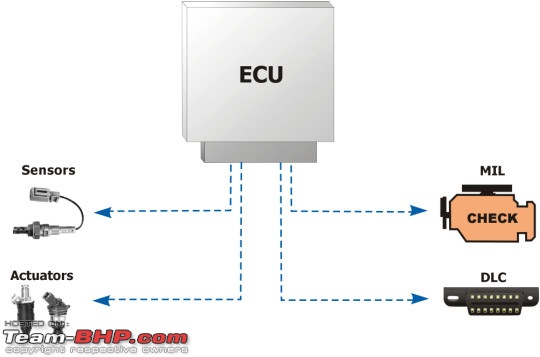
There are two kinds of on-board diagnostic systems:
OBD-I and
OBD-II. OBD - 1
OBD-1 Refers to the first generation OBD systems which were developed throughout the 1980s. These early systems use proprietary connectors, hardware interfaces, and protocols. A mechanic who wanted to access diagnostic information typically had to buy a tool for every different vehicle make. OBD-I scan tools that support multiple protocols are supplied with an array of different adapter cables.
OBD - 2
In the early 1990s, Society of Automotive Engineers (SAE) and International Standardization Organization (ISO) issued a set of standards which described the interchange of digital information between ECUs and a diagnostic scan tool. All OBD-II compliant vehicles were required to use a standard diagnostic connector (SAE J1962), and communicate via one of the standard OBD-II communication protocols.
OBD-II was first introduced in model year (MY) 1994 vehicles, and became a requirement for all cars and light trucks starting with MY1996.

----------------------------------------------------------------------------------------------------------------------------------------------------
How do I know whether my car is OBD-II compliant?
There are several ways.
1996 or newer model year vehicle sold in the United States
United States legislation requires all cars and light trucks model year (MY) 1996 and newer to be OBD-II compliant. More information is available on the EPA's website.
2001 or newer model year gasoline vehicle sold in the European Union
Commission Directive 70/220/EEC, Annex I:
8.1. Vehicles with positive-ignition engines
With effect from 1 January 2000 for new types and from 1 January 2001 for all types, vehicles of category M1, except vehicles the maximum mass of which exceeds 2500 kg, and vehicles of category N1 class I, must be fitted with an on-board diagnostic (OBD) system for emission control in accordance with Annex XI.
Note that here "European Union" means countries which were members of the EU in 2000.
2004 or newer model year diesel vehicle sold in the European Union
Commission Directive 70/220/EEC, Annex I:
8.2. Vehicles with compression-ignition engines
Vehicles of category M1, except
- vehicles designed to carry more than six occupants including the driver,
- vehicles whose maximum mass exceeds 2500 kg,
from 1 January 2003 for new types and from 1 January 2004 for all types, must be fitted with an on-board diagnostic (OBD) system for emission control in accordance with Annex XI.
Note that here "European Union" means countries which were members of the EU in 2003.
Other vehicles
If your vehicle does not fall into any of the above categories, look under the hood and try to locate a label (Fig. 1) that explicitly states that the vehicle was designed to comply with OBD-II legislation.

Fig. 1 - Vehicle Emission Control Information Label
In this case, OBD-II is used as a general term and can mean any of the following:
OBD II (California ARB)
EOBD (European OBD)
JOBD (Japanese OBD)
You may also consult your vehicle's owner's manual and perhaps contact your local dealer. However, be aware of the fact that many dealers do not know the difference between OBD and OBD-II.
If the vehicle is not OBD-II compliant, you cannot use a generic OBD-II scan tool such as ElmScan to obtain diagnostic information from your vehicle.
But my car has the 16-pin OBD connector, shouldn't it be OBD-II compliant?
No, not necessarily. A lot of European and Asian manufacturers equipped their vehicles with D-shaped 16-pin connectors long before they began installing OBD-II systems on those vehicles. One curious thing to note here is the fact that most non-EOBD compliant vehicles had a DLC that does not fully conform to SAE J1979. Compare figures 2 and 3, and notice the "ears" on the non-EOBD compliant Ford Focus.

Fig. 2 - Ford Escort DLC
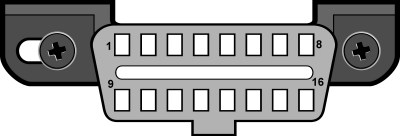
Fig. 3 - J1962 Vehicle Connector, Type A
----------------------------------------------------------------------------------------------------------------------------------------------------
Which OBD-II protocol is supported by my vehicle?
All cars and light trucks built for sale in the United States after 1996 are required to be OBD-II compliant. The European Union OBD legislation is somewhat more complicated.
An OBD-II compliant vehicle can use any of the five communication protocols: J1850 PWM, J1850 VPW, ISO9141-2, ISO14230-4 (also known as Keyword Protocol 2000), and more recently, ISO15765-4/SAE J2480 (a "flavor" of CAN). US car manufacturers were not allowed to use CAN until model year 2003, but as of model year 2008 and going forward, all vehicles will use the CAN protocol.
There are two types of diagnostic link connectors (DLCs) defined by SAE J1962 - Type A and Type B, shown in Figures 2 and 3, respectively. The main difference between the two connectors is in the shape of the alignment tab.
Location - According to J1962, Type A DLC "shall be located in the passenger or driver's compartment in the area bounded by the driver's end of the instrument panel to 300 mm (~1 ft) beyond the vehicle centerline, attached to the instrument panel and easy to access from the driver's seat. The preferred location is between the steering column and the vehicle centerline."
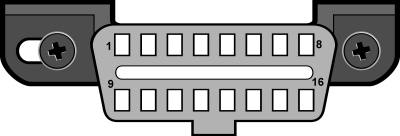
Fig. 1 - J1962 Vehicle Connector, Type A
Type B DLC "shall be located in the passenger or driver's compartment in the area bounded by the driver's end of the instrument panel, including the outer side, and an imagined line 750 mm (~2.5 ft) beyond the vehicle centerline. It shall be attached to the instrument panel and easy to access from the driver's seat or from the Co-drivers seat or from the outside. The vehicle connector shall be mounted to facilitate mating and unmating."

Fig. 2 - J1962 Vehicle Connector, Type B
As a general rule, you can determine which protocol your vehicle is using by looking at the pinout of the DLC:

Fig. 3
The following table explains how to determine the protocol:
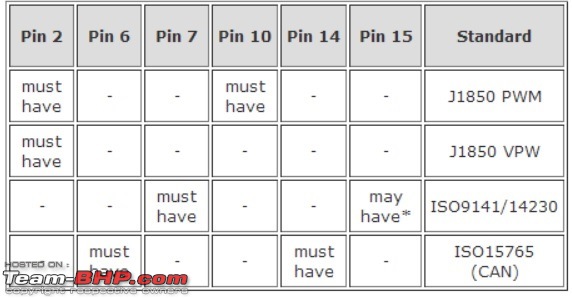
*Pin 15 (also called the "L-line") is optional in newer vehicles that use the ISO9141-2 or ISO14230-4 protocols.
In addition to pins 2, 7, 10, and 15, the connector should have pins 4 (Chassis Ground), 5 (Signal Ground), and 16 (Battery Positive). This means that:
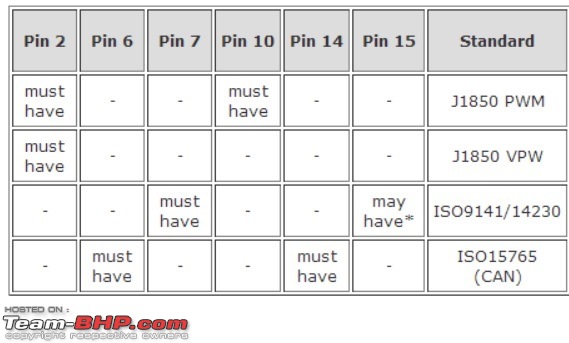
The following image gives the meaning of the 16 pins in the OBD - II connector.
 Source: http://www.obdsol.com/articles/on-bo...s/what-is-obd/ https://www.scantool.net/support/ind...icleid=2&nav=0 https://www.scantool.net/support/ind...icleid=3&nav=0
Source: http://www.obdsol.com/articles/on-bo...s/what-is-obd/ https://www.scantool.net/support/ind...icleid=2&nav=0 https://www.scantool.net/support/ind...icleid=3&nav=0
MODS: There are a few threads on OBD. Didn't understand where to post this information. So please move it to the right thread or a new thread altogether for discussions further.
Cheers,
Anurag.
 (32)
Thanks
(32)
Thanks

 (1)
Thanks
(1)
Thanks
 (14)
Thanks
(14)
Thanks
 (8)
Thanks
(8)
Thanks
 (7)
Thanks
(7)
Thanks
 (1)
Thanks
(1)
Thanks

 (1)
Thanks
(1)
Thanks
 (1)
Thanks
(1)
Thanks


















